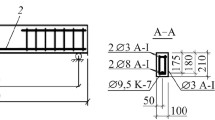The results of experimental investigations and the method of digital image correlation are used to investigate the variations of the mechanical characteristics of the material of thermally hardened steel reinforcement across the thickness of a bar. The conventional and true stress–strain diagrams of the solid reinforcement and standard specimens made of this reinforcement are plotted. We determine the specific fracture energy for different zones of thermally hardened reinforcement. The necessity of taking into account the variations of the mechanical characteristics across the thickness of the bar in the design of building structures and the advantages of application of the specific fracture energy as an invariant characteristic of the material are demonstrated.




Similar content being viewed by others
References
GOST 1497-84. Metals. Methods for Tensile Testing [in Russian], Izd. Standartov, Moscow (1985).
G. S. Pisarenko and V. A. Strizhalo, Experimental Methods in the Mechanics of Deformable Bodies [in Russian], Naukova Dumka, Kiev (1986).
Ya. B. Fridman, Mechanical Properties of Metals, Vol. 1: Deformation and Fracture [in Russian], Mashinostroenie, Moscow (1974).
T. Chu, W. Ranson, and M. Sutton, “Applications of digital-image-correlation techniques to experimental mechanics,” Exp. Mech., 25(3), 232–244 (1985).
B. Pan, K. M. Qian, H. M. Xie, and A. Asundi, “Two-dimensional digital image correlation for in-plane displacement and strain measurement: A review,” Meas. Sci. Technol., 20(6), 062001–062007 (2009).
Yu. V. Mol’kov, “Application of the method of digital image correlation to the construction of stress–strain diagrams,” Fiz.-Khim. Mekh. Mater., 48, No. 6, 121–125 (2012); English translation: Mater. Sci., 48, No. 6, 832–837 (2013).
Ya. L. Ivanyts’kyi, Yu. V. Mol’kov, P. S. Kun,’ et al., “Determination of the local strains near stress concentrators by the digital image correlation technique,” Fiz.-Khim. Mekh. Mater., 50, No. 4, 18–24 (2014); English translation: Mater. Sci., 50, No. 4, 488–495 (2014).
L. F. Gillemot, “Сriterion of crack initiation and spreading,” Eng. Fract. Mech., 8, 239–253 (1976).
H. J. Schindler, “Strain energy density as the link between global and local approach to fracture,” in: K. Ravi-Chandar, et al., (editors), Proc. of the 10th Internat. Conf. on Fracture, Pergamon, Honolulu (2001), Reference ID: ICF 100494OR.
Author information
Authors and Affiliations
Corresponding author
Additional information
Published in Fizyko-Khimichna Mekhanika Materialiv, Vol. 50, No. 6, pp. 50–54, November–December, 2014.
Rights and permissions
About this article
Cite this article
Zhang, Q., Mol’kov, Y.V., Sobko, Y.М. et al. Determination of the Mechanical Characteristics and Specific Fracture Energy of Thermally Hardened Reinforcement. Mater Sci 50, 824–829 (2015). https://doi.org/10.1007/s11003-015-9789-9
Received:
Published:
Issue Date:
DOI: https://doi.org/10.1007/s11003-015-9789-9




